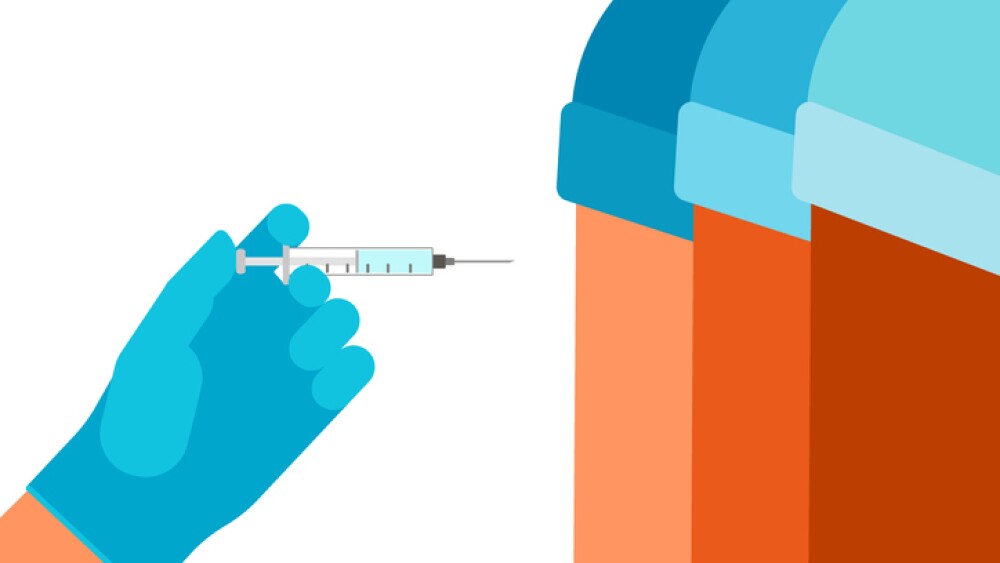In the study the incidence and susceptibility of extended-spectrum ß-lactamase producing Enterobacteriaceae (ESBLE) and ciprofloxacin-resistant Enterobacteriaceae (CIPRE) to doripenem and relevant comparators was evaluated. The data analyzed was pooled from six large, multi-national Phase III clinical trials, including trials that focused on complicated urinary tract infections (cUTIs) and pyelonephritis (2); complicated intra-abdominal infections (cIAI) (2); nosocomial pneumonia (NP), including early-onset ventilator-associated pneumonia (VAP) (1); and VAP, both early- and late-onset (1).
The study results showed:
• Against ESBLE and CIPRE, doripenem was generally more potent in vitro than imipenem and ertapenem, and inhibited growth of CIPRE and ESBLE at very low drug concentrations.
• Doripenem, imipenem and ertapenem, inhibited growth of >90% of ESBLE at concentrations of 0.25 µg/mL, 0.5 µg/mL, and 1 µg/mL, respectively.
• Similarly, doripenem, imipenem and ertapenem inhibited the growth of >90% of CIPRE at concentrations of 0.5 µg/mL, 1 µg/mL, and 4 µg/mL, respectively.
Additionally, the study examined the incidence of ESBLE and CIPRE in baseline Enterobacteriaceae isolates in North America (NA), South America (SA), and Europe (EU). To evaluate these levels, minimum inhibitory concentrations (MICs) were determined for ESBLE and CIPRE. ESBLE were determined as Enterobacteriaceae that included Escherichia coli, Klebsiella spp., and Proteus spp. with ceftazidime MICs > 2µg/mL. CIPRE were defined as Enterobacteriaceae with ciprofloxacin MIC > 4µg/mL. The study results showed:
• Relative incidence of ESBLE was highest in Europe (8% of all Enterobacteriaceae), and the relative incidence of CIPRE was highest in South America (16%).
• In ESBLE from all regions combined, 68% were resistant to ciprofloxacin while 98% had doripenem MICs < 2µg/mL.
• In CIPRE from all regions combined, 99% had carbapenem MICs < 4µg/mL.
A second study, also presented at the 2008 ICAAC/IDSA Joint Meeting (Abstract #: C1091), that examined stored clinical Enterobacteriaceae isolates found that overall susceptibility (< 0.5 µg/mL) for doripenem among Enterobacteriaceae strains were 98.9% and 96.5% for strains expressing ESBL and AmpC ß-lactamase enzymes, respectively. Both ESBL and AmpC ß-lactamase are enzymes that destroy cephalosporins and other related antibiotics. Approximately, 32,993 Enterobacteriaceae isolates in four geographic locations (North America, Latin America, Europe and Asia-Pacific) were recovered from more than 60 medical centers, which participated in the global doripenem surveillance program from 2003 to 2007.
In this study susceptibility testing was performed by the monitoring laboratory using Clinical and Laboratory Standards Institute (CLSI) methods and interpretive criteria. Overall, the Enterobacteriaceae doripenem-susceptibility rate (< 0.5µg/mL) was 98.9%. ESBLs were detected in 5.7, 17.3 and 4.8% of E. coli, Klebsiella spp. and P. mirabilis, respectively; AmpC-production rates were 1.6, 23.7, 2.2 and 2.7% for Citrobacter spp., Enterobacter spp., indole-positive Proteae and Serratia spp. ESBL and AmpC enzymes had little impact on doripenem MIC50 potencies (up to two-fold). Sporadic occurrence of Bush group 2f carbapenemases (KPC) among Klebsiella spp. was detected along with rare metallo-ß-lactamases in other Enterobacteriaceae, elevating carbapenem MICs.
About Extended-spectrum ß-lactamases (ESBLs)
A type of Enterobacteriaceae, extended-spectrum ß-lactamases (ESBLs) are a growing concern for physicians treating hospitalized patients. Infection with ESBLs are especially prevalent in intensive care units (ICUs) and are associated with high rates of morbidity and mortality, prolonged hospital stay and higher costs.[iii] ESBLs represent a significant threat in the infectious diseases field.[iv]
About DORIBAX™ (doripenem for injection) DORIBAX is an intravenous (IV) antibiotic for hospital use, and belongs to a class of antibacterial drugs called carbapenems. Carbapenems are important antibiotics to treat serious - and often life-threatening - infections caused by a broad range of bacteria.
DORIBAX was approved in the U.S. in October 2007 for the treatment of complicated intra-abdominal infections (cIAI) and complicated urinary tract infections (cUTI), including pyelonephritis, due to susceptible bacteria, and is marketed by Ortho-McNeil, Division of Ortho-McNeil-Janssen Pharmaceuticals, Inc. DORIBAX is also approved in the EU and Russia for cIAI, cUTI and NP, including VAP. Doripenem is licensed from Shionogi & Co., Ltd.
INDICATIONS
DORIBAX? (doripenem for injection) is indicated as a single agent for the treatment of:
• Complicated intra-abdominal infections caused by susceptible strains of E. coli, K. pneumoniae, P. aeruginosa, B. caccae, B. fragilis, B. thetaiotaomicron, B. uniformis, B. vulgatus, S. intermedius, S. constellatus or P. micros, and
• Complicated urinary tract infections, including pyelonephritis, caused by susceptible strains of E. coli, including cases with concurrent bacteremia, K. pneumoniae, P. mirabilis, P. aeruginosa, or A. baumannii.
To reduce the development of drug-resistant bacteria and maintain the effectiveness of DORIBAX and other antibacterial drugs, DORIBAX should be used only to treat infections that are proven or strongly suspected to be caused by susceptible bacteria. When culture and susceptibility information are available, they should be considered in selecting and modifying antibacterial therapy. In the absence of such data, local epidemiology and susceptibility patterns may contribute to the empiric selection of therapy.
IMPORTANT SAFETY INFORMATION
DORIBAX is contraindicated in patients with known serious hypersensitivity to doripenem or other carbapenems or in patients who have demonstrated anaphylactic reactions to beta-lactams.
Serious and occasionally fatal hypersensitivity (anaphylactic) and serious skin reactions have been reported in patients receiving beta-lactam antibiotics. These reactions are more likely to occur in individuals with a history of sensitivity to multiple allergens. If an allergic reaction to DORIBAX occurs, discontinue the drug. Serious acute anaphylactic reactions require emergency treatment with epinephrine and other emergency measures, including oxygen, IV fluids, IV antihistamines, corticosteroids, pressor amines and airway management, as clinically indicated.
Carbapenems may reduce serum valproic acid concentrations to subtherapeutic levels, resulting in loss of seizure control. Serum valproic acid concentrations should be monitored frequently after initiating carbapenem therapy. Alternative antibacterial or anticonvulsant therapy should be considered if serum valproic acid concentrations cannot be maintained in the therapeutic range or seizures occur.
Clostridium difficile-associated diarrhea (CDAD) has been reported with use of nearly all antibacterial agents and may range in severity from mild diarrhea to fatal colitis. CDAD must be considered in all patients who present with diarrhea following antibiotic use. Careful medical history is necessary since CDAD has been reported to occur over two (2) months after administration of antibacterial agents. If CDAD is suspected or confirmed, ongoing antibiotic use not directed against C. difficile may need to be discontinued.
When DORIBAX has been used investigationally via inhalation, pneumonitis has occurred. DORIBAX should not be administered by this route.
Safety and effectiveness in pediatric patients have not been established.
The most common adverse reactions (?5%) observed in clinical trials were headache, nausea, diarrhea, rash and phlebitis.
Please see the DORIBAX Full Prescribing Information by visiting www.DORIBAX.com
Johnson & Johnson Pharmaceutical Research & Development, L.L.C.
Johnson & Johnson Pharmaceutical Research & Development, L.L.C. (J&JPRD) is part of Johnson & Johnson, the world’s most broadly-based producer of healthcare products. J&JPRD is headquartered in Raritan, NJ, and has facilities throughout Europe, the United States and Asia. J&JPRD is leveraging drug discovery and drug development in a variety of therapeutic areas to address unmet medical needs worldwide.
[This press release contains “forward-looking statements” as defined in the Private Securities Litigation Reform Act of 1995. These statements are based on current expectations of future events. If underlying assumptions prove inaccurate or unknown risks or uncertainties materialize, actual results could vary materially from the Company’s expectations and projections. Risks and uncertainties include general industry conditions and competition; economic conditions, such as interest rate and currency exchange rate fluctuations; technological advances and patents attained by competitors; challenges inherent in new product development, including obtaining regulatory approvals; domestic and foreign health care reforms and governmental laws and regulations; and trends toward health care cost containment. A further list and description of these risks, uncertainties and other factors can be found in Exhibit 99 of Johnson & Johnson’s Annual Report on Form 10-K for the fiscal year ended December 31, 2006. Copies of this Form 10-K, as well as subsequent filings, are available online at www.sec.gov or on request from the Company. The Company does not undertake to update any forward-looking statements as a result of new information or future events or developments.]
For more information on Johnson & Johnson, please visit the Company’s web site at www.jnj.com.




